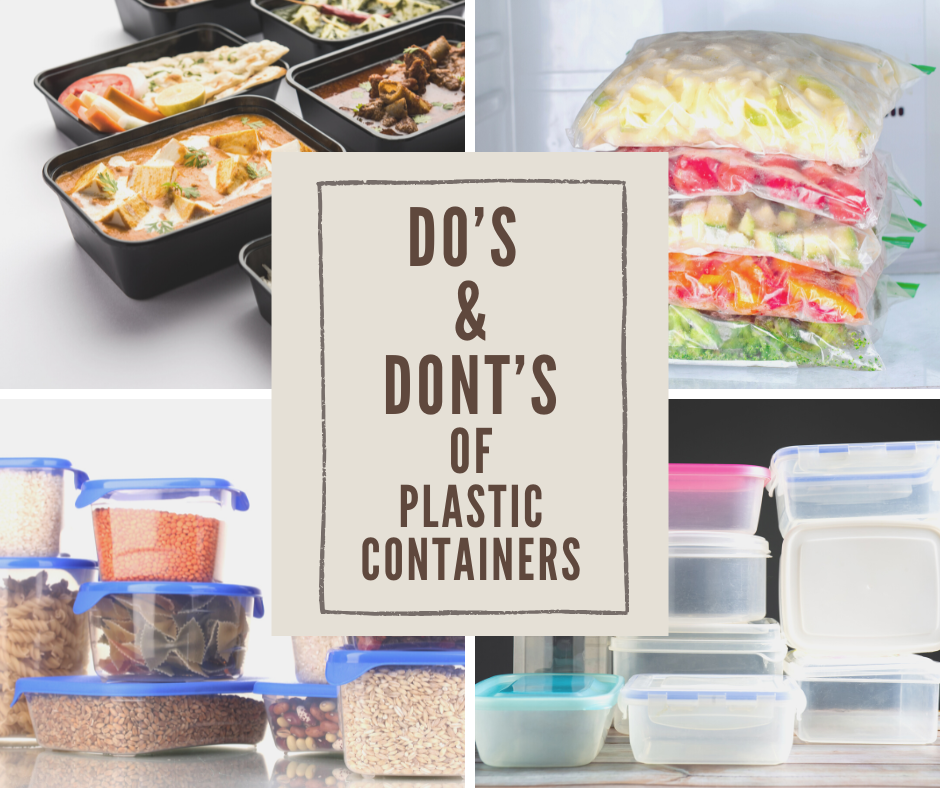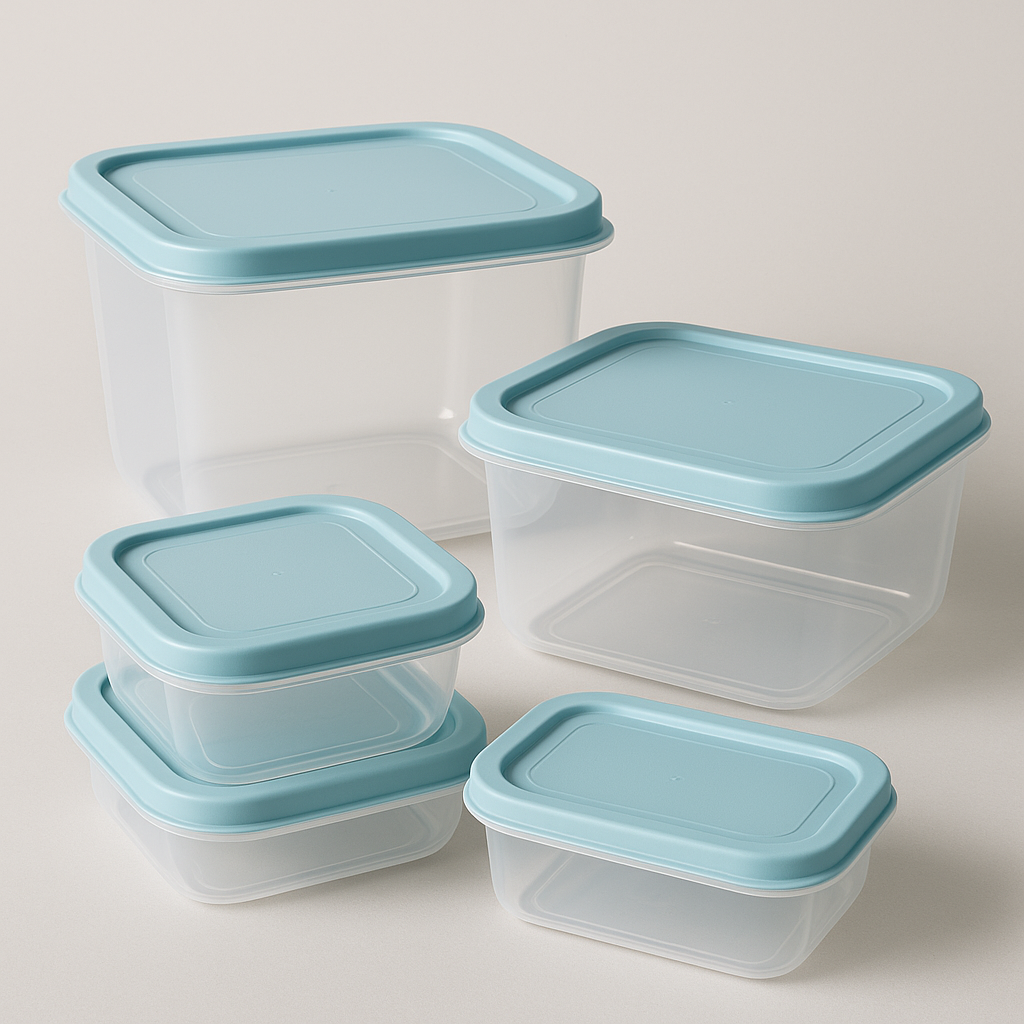Plastic Food Containers: What to Store (and Not)
It’s easy to grab a plastic tub or deli container to store leftovers or pack lunch — we all do it. But recent scientific studies have raised concerns about what happens when plastic food containers come into contact with hot food, acidic foods, or fatty foods. Learn all about Plastic food containers: What to store (and not). Avoid microplastics and use top quality safe food containers.
I switched all of my plastic containers to glass recently. It really makes you think when you walk through the grocery store and see so much plastic! Yikes!
Understanding how and when to use plastic products — and when to switch to glass containers or stainless steel containers — can make a big difference for your health and your kitchen habits.

What Are Microplastics — and Are They Really That Bad?
Microplastics are teeny-tiny pieces of plastic, smaller than five millimeters, that come from the breakdown of larger plastic products—like food containers, utensils, and even tea bags. They’re so small you can’t see them, but they’re practically everywhere.
Over time, these invisible particles have been found in our oceans, soil, air, and even inside our bodies. Studies have detected them in the lungs, bloodstream, and even the placenta, which has scientists understandably concerned about how they might affect our health.
Research on microplastics is still evolving, but what we know so far isn’t exactly comforting. Recent studies show that plastic food containers can shed microplastics, especially when they’re heated or worn down. That’s why many experts recommend swapping plastic for glass or stainless steel whenever you can—it’s a simple way to cut down on daily exposure.
The Problem with Plastic and High Temperatures
When you pour hot food like tomato sauce or citrus fruits into plastic storage containers, or reheat them in the microwave, harmful chemicals such as bisphenol A (BPA) and phthalates can leach into your food.
These toxic chemicals are known endocrine disruptors, which means they can interfere with hormones and affect human health, including immune systems and human tissues. The U.S. Food and Drug Administration (FDA) has set limits, but many experts, including Bryan Quoc Le of UC Irvine, suggest there’s still a good reason to minimize long-term use of plastic with food.

What Foods Should Never Be Stored in Plastic
The following foods should never be stored in plastic. Keep this in mind when shopping at the grocery store.
1. Hot Food
High heat and high fat content are two of the biggest triggers for leaching. Avoid storing the following in plastic tubs or airtight plastic containers.Never pour hot food straight into plastic food containers. High temperatures can cause plastics to release harmful chemicals like bisphenol A (BPA) and phthalates into your meal. Always let food cool to room temperature before storing.
2. Tomato Sauce and Acidic Foods
Tomato sauce, citrus fruits, and other acidic foods can react with plastic, breaking down the material and leaching toxic chemicals into your food. These acids are especially harsh on plastic tubs and airtight plastic containers. Store them in glass food containers or stainless steel containers instead.
3. Fatty Foods and Dairy Products
Butter, soft cheeses, cream-based dishes, and high-fat content meals tend to absorb more chemicals from plastic. Fatty foods pull in compounds from plastic packaging — not something you want mixed with your mac and cheese. Use glass jars or metal containers for a better alternative.
4. Raw Meat and Fish
Keeping raw meat or seafood in reused plastic containers can trap harmful bacteria, leading to foodborne illnesses or even food poisoning. It’s also tricky to clean these plastics well enough for food safety. Opt for airtight containers made of glass or stainless steel — a great option for sanitation and durability.
5. Soft Cheeses and Creamy Sauces
Soft cheeses and sauces like Alfredo or ranch dressing should be stored in glass containers. These foods spoil faster in plastic because of moisture buildup, and the high fat content increases the chance of chemical transfer.
6. Fresh Herbs and Leafy Greens
It might seem convenient, but storing leafy greens or fresh herbs in plastic bags often leads to sogginess and spoilage. The trapped moisture creates a breeding ground for harmful bacteria. A dry place with cloth bags or beeswax wraps is a good idea for keeping them crisp longer.
7. Citrus Fruits
The acid in citrus fruits can degrade plastic and cause plastic taste transfer. They’re best stored loose, in stainless steel containers, or wrapped in beeswax wraps to maintain freshness.
8. High-Fat Leftovers or Fast Foods
Greasy takeout and fast foods can dissolve plastic coatings, releasing toxic chemicals into your meal. Transfer them into glass containers or stainless steel work bowls once you get home.
How to Identify Safer Plastics
If you must use plastic, check the resin identification code — that little triangle on the bottom of containers. The general consensus is to avoid codes #3, #6, and #7, which are more likely to contain harmful chemicals or high levels of BPA. Plastic bottles and plastic water bottles should never be exposed to high heat (like a hot car), as this increases the risk of chemical migration.
The Health Risks of Long-Term Plastic Use
The widespread presence of plastic in food packaging, baby bottles, and plastic bags has led scientists to explore its potential health effects — from hormone disruption to chronic diseases. Some research even shows traces of microplastics in human tissues. While the evidence is still developing, there’s good news: safer, better alternatives exist.
Amazon’s Most Popular Safe Food Containers
Better Alternatives for Food Storage
- Glass containers – A good choice for reheating or long-term storage.
- Stainless steel work bowls or containers – Durable and ideal for high heat or fast foods.
- Beeswax wraps and cloth bags – A great option for wrapping sandwiches or covering bowls.
- Glass jars – Perfect for pantry staples and dry foods.
When food shopping at bulk stores, bring reusable bags or a cloth bag to cut down on unnecessary plastic and single-use plastic. Glass and metal are way more sustainable as well.
Why It Matters for Families and Young Children
For households with young children, minimizing plastic food storage is especially important. Babies and toddlers are more sensitive to endocrine disruptors, and even low exposure can affect growth and development. Using glass food containers, metal containers, or stainless steel containers is a good idea for keeping meals safe — especially over a long time.
The Best Way to Store Different Types of Food
Dry goods like rice, beans, and pasta: Use airtight containers or glass jars stored in a dry place to avoid moisture buildup. Fresh fruits, leafy greens, and fresh herbs: Line containers with a towel or use beeswax wraps to reduce plastic waste — a great way to keep produce crisp. Dry foods and non-food items: Store these in stainless steel containers or plastic-free options when possible.
Final Thoughts: A Sustainable, Healthy Kitchen Starts Small
You don’t need to overhaul your entire kitchen overnight. Start by swapping out plastic bottles for reusable glass or stainless steel ones. Store acidic foods and fatty foods in glass containers. Buy dry goods from bulk stores in reusable bags. Each step reduces unnecessary plastic and supports both food safety and human health.
Choosing the best option for every type of food container — from food wraps to airtight containers — is a great way to protect your family and the planet. When it comes to food packaging, remember: plastic isn’t always fantastic, and a little awareness goes a long way.





![[8-Pack,30 oz]Glass Meal Prep Containers,Glass Food Storage Containers,Airtight lunch Containers with Lids, Microwave, Oven, Freezer and Dishwasher](https://m.media-amazon.com/images/I/51Xx2N0Mc7L._SL500_.jpg)






